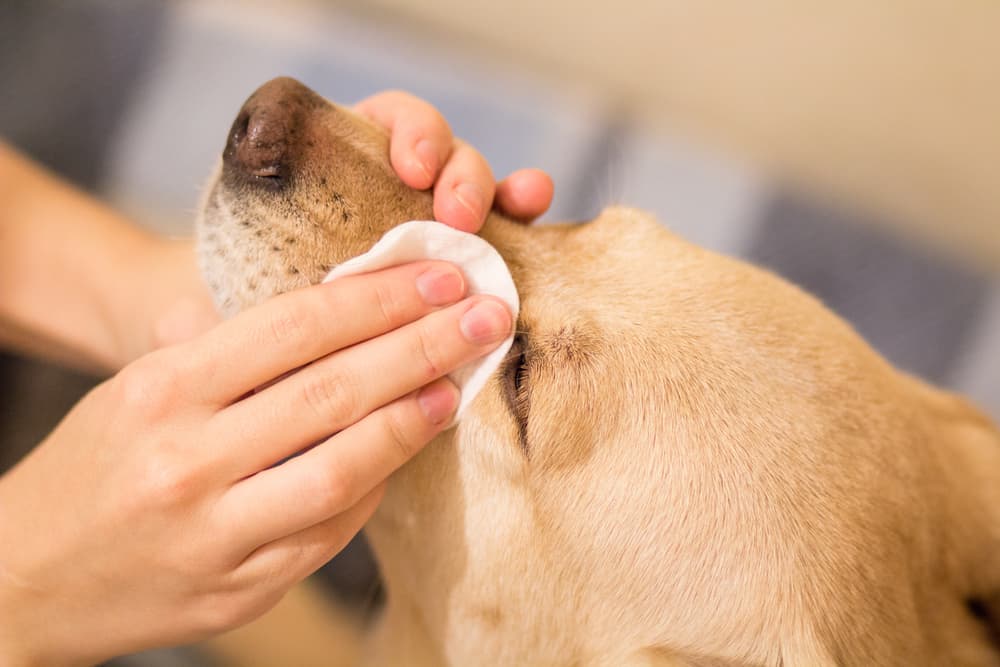Does your dog have rust-brownish-coloured tear stains on their fur around the eyes? They don’t look nice, right? And you are probably worried they might mean there’s some serious health issue hiding behind. Tear stains are a common issue for many dog breeds, especially those with white or light-coloured fur. These stains are often caused by excessive tearing, which can be attributed to various factors such as genetics, eye infections, or blocked tear ducts.
To address this concern, pet owners often turn to tear stain removers designed specifically for dogs. Before you find the best way to treat this condition, will explore the causes of tear stains, effective treatment options, and practical preventive measures.
What Causes Tear Stains?

Unless your little furry friend has been in a boxing match with your cat (they really can throw some punches), there’s a reasonable explanation for this condition.
Genetics
Certain breeds are more prone to tear stains due to their facial anatomy. Breeds with shallow eye sockets or prominent eyes, such as Shih Tzus, Maltese, and Poodles, often experience tear staining.
Blocked Tear Ducts
If a dog’s tear ducts are blocked or not functioning properly, tears may overflow onto the fur, leading to staining. This can be caused by congenital issues, debris, or infections.
Excessive Tearing
Allergies, irritants, or foreign objects can cause excessive tearing in dogs. The tears, containing natural pigments, can stain the fur when not properly drained or wiped away.
Dietary Factors
Poor diet or food allergies may contribute to tear stains. Ingredients in some dog foods can lead to tear production changes or allergic reactions, resulting in staining.
What Are Tear Stain Removers?

One popular type of tear stain remover is a topical solution that helps break down and eliminate the discolouration around the eyes. These solutions typically contain mild, pet-safe ingredients such as boric acid, chamomile, and aloe vera. Boric acid helps to cleanse the stained area, while chamomile and aloe vera provide soothing and anti-inflammatory properties.
Another type of pet eye stain remover comes in the form of wipes or pads. These are pre-moistened with a gentle solution and can be used to wipe away tear stains from the fur around the eyes. These wipes are convenient for quick clean-ups and are often enriched with natural ingredients like witch hazel to help soothe the eye area. Regular use can prevent staining and maintain a clean appearance.
Do Tear Stain Removers Really Work?
Don’t expect the tear stain remover to work like bleach so you can see results immediately. Its purpose is to clear away the gunk that has already built up and stop future staining. If the pup has permanently dyed fur, it will grow out and you can trim it off. Then you can continue to apply the remover regularly to prevent the condition from coming back.
Are They Pet-Friendly?
It’s crucial to choose tear stain removers specifically formulated for dogs to ensure they are safe for your pet’s sensitive eye area. Avoid using products designed for humans, as they may contain ingredients that can be harmful to dogs. When using a tear remover, it’s essential to follow the product instructions carefully. Overuse or misuse of these products can lead to irritation or other adverse reactions. Additionally, it’s a good idea to consult with your veterinarian before introducing any new products into your dog’s grooming routine, especially if your dog has pre-existing eye conditions.
Other Treatment Options
- Veterinary Examination: If tear stains persist or worsen, it’s crucial to consult a veterinarian. They can identify any underlying health issues, such as infections, blocked tear ducts, or allergies.
- Tear Duct Flushing: In cases of blocked tear ducts, your vet may recommend flushing the ducts to clear obstructions. This procedure can help restore normal tear drainage and reduce staining.
- Topical Treatments: Veterinarians may prescribe or recommend topical treatments, such as antibiotics or steroids, to address infections or inflammation contributing to tear staining.
Preventive Measures
As with other issues, the best way is to try and prevent them in the first place, so that both you and your puppy don’t have to go through a lot of trouble. Proper home-grooming steps and a good diet can work like magic. Here are some tips on that:
- Proper Hygiene: Regularly cleaning your dog’s face with a damp cloth can prevent tear stains from accumulating. Ensure that the fur around the eyes stays clean and dry.
- High-Quality Diet: Opt for a balanced, high-quality diet that meets your dog’s nutritional needs. Avoid ingredients that may trigger allergies or sensitivities.
- Regular Veterinary Check-ups: Schedule regular check-ups with your veterinarian to monitor your dog’s overall health, address potential issues promptly, and receive professional guidance on tear stain management.
The Takeaway
Tear stains in dogs are a manageable concern with proper understanding and care. By addressing the underlying causes, seeking veterinary guidance, and incorporating preventive measures, you can keep your furry friend’s eyes clean and healthy, enhancing both their appearance and overall well-being. Tear stain removers for dogs come in various forms, including topical solutions and wipes, with ingredients designed to be gentle yet effective. Regular and proper use of these products, coupled with good overall eye hygiene, can help keep your dog’s eye area clean and free from unsightly tear stains.


















